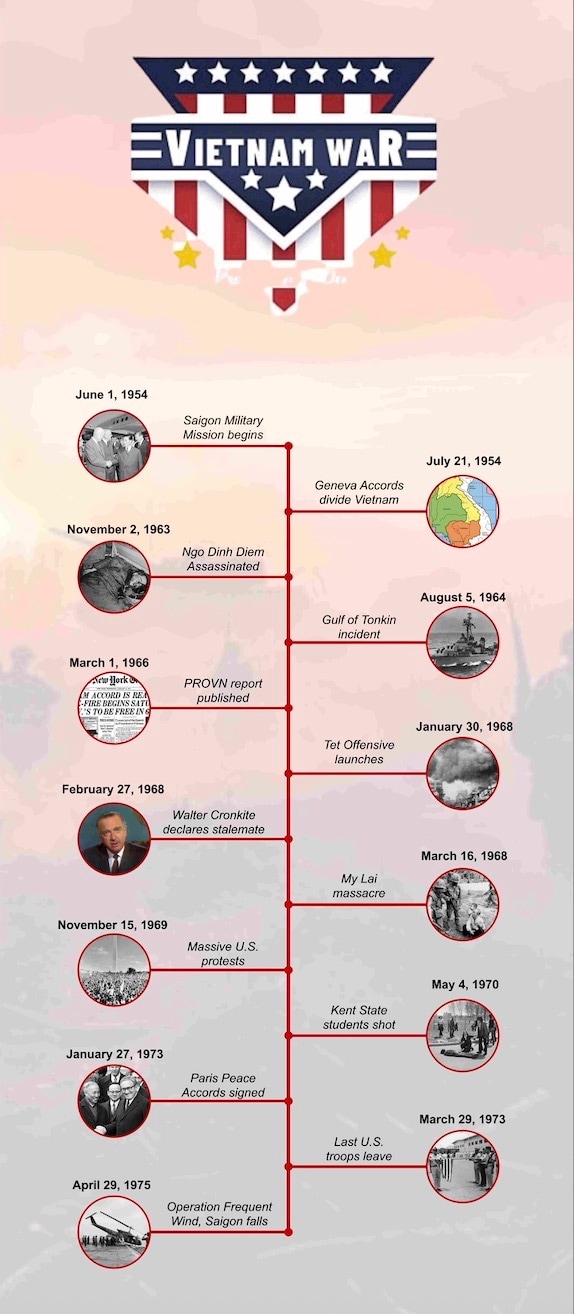The Vietnam War stretched from 1945 to 1975. It began with Vietnam’s struggle to end French colonial rule and later became a major Cold War conflict. North Vietnam had political giants like the Soviet Union and China at its back. It was fighting to unify the country under communism.
However, South Vietnam wanted to maintain its independence. They aimed to prevent Vietnam from becoming a communist state. They got support from the USA, giving them hope to preserve their existing political and social structure.
The war included long battles, heavy bombing campaigns, and widespread protests worldwide. It ended with the fall of Saigon in 1975. The conflict left deep scars in Vietnam and reshaped global politics, making it one of the most important wars of the 20th century.
Vietnam War Timeline
May 7, 1954
Vietnamese forces under General Vo Nguyen Giap shocked the world by defeating the French at Dien Bien Phu. The French had expected a quick win, sitting in their fortified valley. Instead, they were surrounded, bombarded, and starved into surrender.
This wasn’t just a lost battle. It ended French colonial rule in Indochina. After nearly a hundred years, Paris was out. Vietnam’s future would now be decided not by the French, but at the Geneva peace talks.
June 1, 1954
The U.S. sent in the Saigon Military Mission. It was led by Colonel Edward Lansdale, an expert in psychological warfare. The mission wasn’t huge. A handful of men running propaganda and secret operations. But it had big goals. Their task was to support South Vietnam’s new leader, Ngo Dinh Diem, and to weaken communist influence in the countryside.
It didn’t look like much at the time. But this was the first real American footprint in Vietnam. A small mission tied the U.S. to a conflict that would grow into something far larger.
July 21, 1954
The Geneva Accords sliced Vietnam in two. North for the communists, South for the Western-backed government. Elections were promised for 1956 to reunite the country. Spoiler alert: they never happened.
The “temporary” line at the 17th parallel quickly became a border. Setting up two very different governments that would soon clash.
November 2, 1963
Ngo Dinh Diem, South Vietnam’s president, was overthrown by his own generals. For years, Washington supported him, but his corruption and harsh rule lost him allies fast. Once U.S. backing vanished, so did his presidency.
Did this bring stability? Not even close. One shaky government followed another, while the North kept getting stronger. By now, thousands of American soldiers were already in Vietnam – “advisers,” officially. But everyone knew this was no longer just a local fight.
August 5, 1964
The Gulf of Tonkin incident: North Vietnamese boats reportedly attacked U.S. ships. The reports were murky, but in Washington, it didn’t matter. Congress passed the Gulf of Tonkin Resolution, giving President Johnson a blank check to wage war.
Funny thing? Decades later, evidence showed at least one of those “attacks” might never have happened. Safe to say, a whole war escalated over what could’ve been a misunderstanding.
March 1, 1966
The U.S. Army released the PROVN report. It said the current strategy wasn’t working. It argued that General Westmoreland’s focus on killing enemy troops was missing the bigger picture. Victory required winning over the rural population, not just chasing body counts.
But the advice was brushed aside. Instead, troop levels surged to nearly 185,000. Casualties climbed higher. And back home, doubts about the war grew louder. The gap between what experts warned and what commanders did was starting to show.
January 30, 1968
The Tet Offensive shook everything. On Vietnam’s New Year holiday, the Viet Cong and North Vietnamese launched surprise attacks across South Vietnam. Cities, bases, even the U.S. embassy in Saigon came under fire.
Militarily, the U.S. repelled the offensive. But politically? It was a nightmare. Americans back home switched on the evening news and thought: “If we’re winning, why does it look like this?” Public support began to crumble.
February 27, 1968
CBS anchor Walter Cronkite returned from Vietnam and spoke directly to millions of Americans. His verdict: the war looked headed for a stalemate. Coming from “the most trusted man in America,” the words hit hard.
President Lyndon Johnson reportedly told aides, “If I’ve lost Cronkite, I’ve lost Middle America.” The Tet Offensive had shaken confidence. More than any single battle, it was this moment on television that turned public opinion.
March 16, 1968
In the village of My Lai, U.S. soldiers killed hundreds of unarmed civilians. Women, children, and elderly men. It was later called a massacre. For months, the event was covered up. But when the truth surfaced, outrage exploded.
Only one officer, Lieutenant William Calley, was convicted. And he served only a short sentence under house arrest. My Lai became a symbol of the war’s moral collapse. At home and abroad, it deepened anger and distrust toward U.S. involvement.
November 15, 1969
Protesters filled the streets in the largest antiwar demonstrations in American history. Millions demanded an end to the fighting in Vietnam. This wasn’t just students anymore. Clergy, veterans, and families joined the marches.
The war had divided the nation. Demonstrators carried signs, chanted slogans, and called on leaders in Washington to bring the troops home. The pressure to exit Vietnam had never been stronger.
May 4, 1970
At Kent State University, National Guard troops fired on students protesting the war. Four were killed. Nine more were wounded.
The shootings shocked the country. Colleges erupted with strikes and demonstrations. The war had not only torn Vietnam apart. It was now tearing apart America’s own campuses and communities. By this point, 335,000 U.S. troops remained overseas, and nearly 50,000 had died. The home front was as bitter as the battlefield.
January 27, 1973
Peace talks in Paris finally bore fruit. The U.S., North Vietnam, South Vietnam, and the Viet Cong signed an agreement. A ceasefire was declared, and American troops began heading home.
Was it peace at last? Not really. The ink was barely dry before fighting resumed between the North and South. The difference was, the U.S. was no longer there to hold the line.
March 29, 1973
The last U.S. combat troops left Vietnam. After years of fighting, America’s direct role was over. The numbers told the cost: 58,000 Americans killed, millions of Vietnamese dead, and entire villages destroyed.
For the U.S., it was more than a military loss. The war left deep scars on trust in government, reshaped foreign policy, and taught a hard lesson about intervention. For Vietnam, it was utter devastation. But also the beginning of reunification under one flag.
April 30, 1975
The end came with the fall of Saigon. North Vietnamese tanks rolled through the city gates as helicopters frantically evacuated Americans and South Vietnamese allies from rooftops. The images became iconic – a superpower pulling out in chaos.
For Vietnam, it was reunification under communist rule. For America, it was a bruising chapter: tens of thousands dead, millions of Vietnamese lives lost, and a nation questioning its own power.
And for history? A reminder that wars aren’t just fought with weapons. They’re fought with politics, public opinion, and sometimes… over reports of “attacks” that may or may not have even happened.
How to Make a Similar Timeline in EdrawMax?
The Vietnam War was one of the most defining conflicts of the 20th century. Stretching over two decades, it reshaped politics, societies, leaving behind a lot of lessons. From the fight against colonial rule to the Cold War tensions that followed, it was never just about one nation. It was about choosing the right sides.
And if you want to keep track of all those turning points without losing the bigger picture, timelines are your best friend. That’s where EdrawMax, a comprehensive timeline creator, comes in. Whether you’re starting fresh or already know your way around, it makes building timelines simple and effective.
Ready to map? Let’s begin.
Step1Get EdrawMax
- Download the software on your computer.
- Log in or create a Wondershare account to get started.

Step2Begin your Timeline
- To create a new project: go to Basic Diagram > Timeline > Blank Drawing.
- Want to save time? Head to the Templates section on the homepage.
- For this walkthrough, we’ll stick with the Blank Drawing option to start a timeline from scratch.
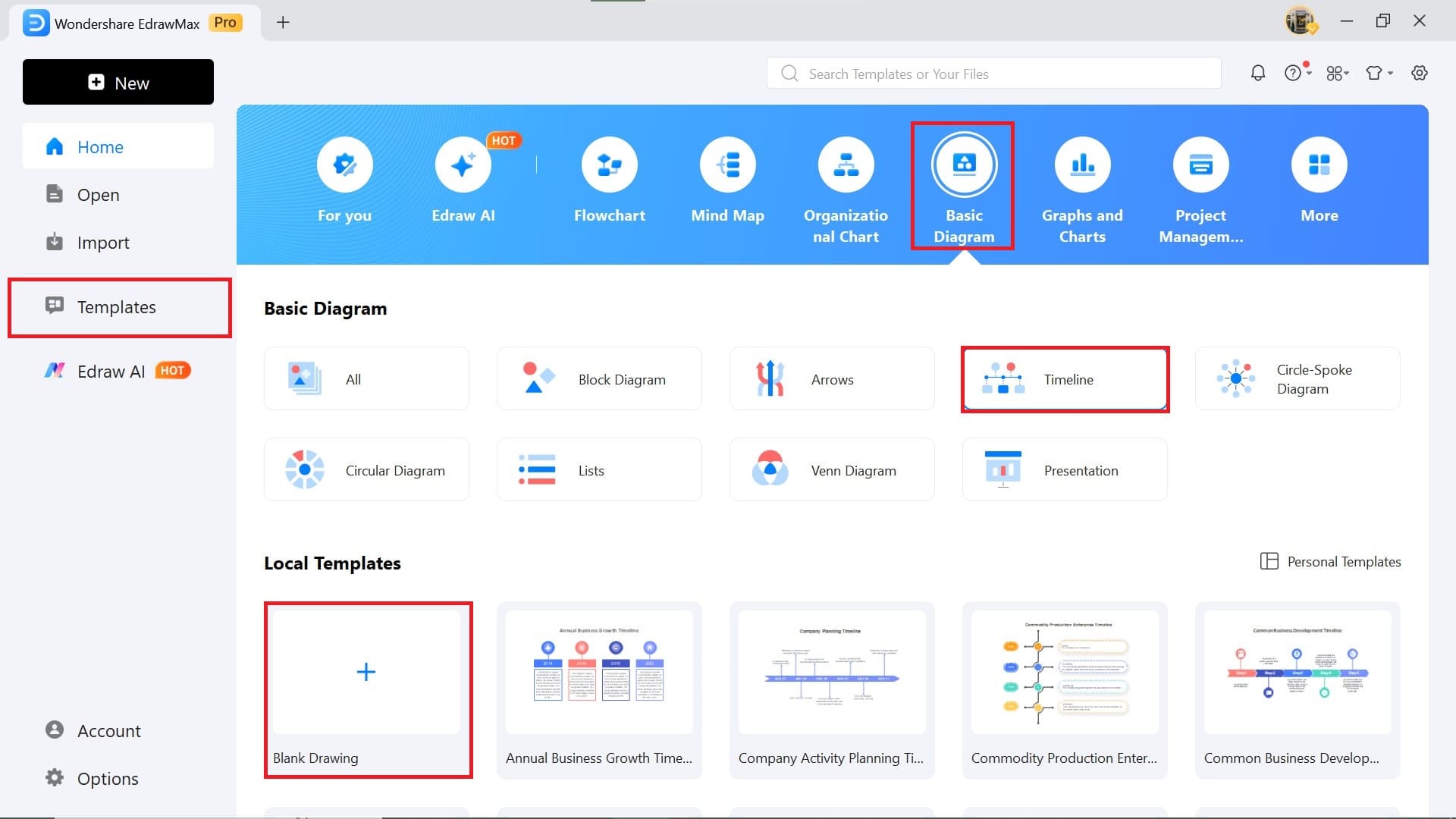
Step3Pick a Timeline Layout
- On the canvas, look to the left panel. Click Symbols.
- Drag and drop whichever timeline layout best fits your project.
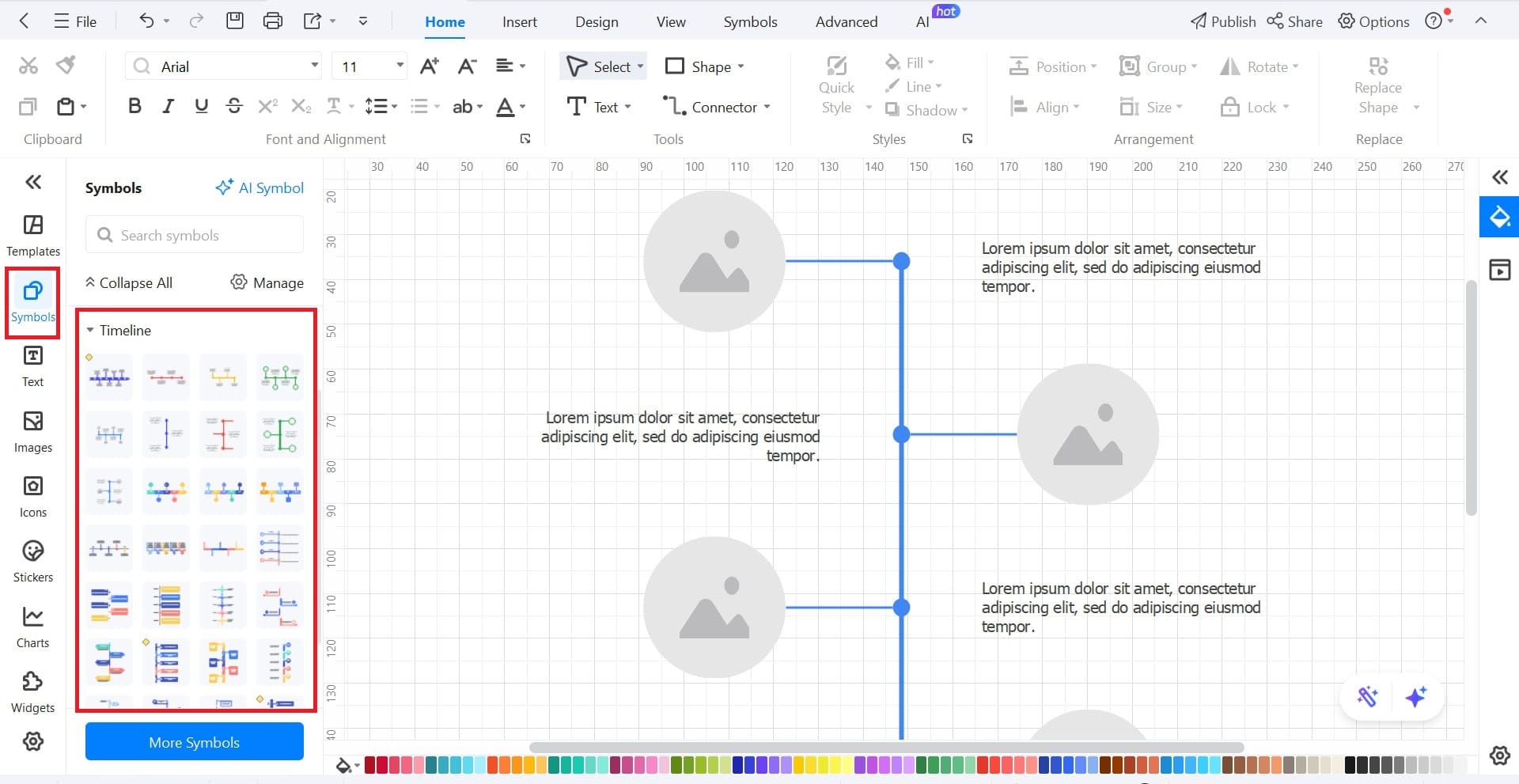
Step4Edit your Timeline
Click the timeline, and you’ll see a floating toolbar.
- Use Number to add or remove timeline divisions.
- Use Picture Size to adjust image frames.
- Use Horizontal Interval to control spacing between events.
- Add text by dragging and dropping text boxes from the Text section.
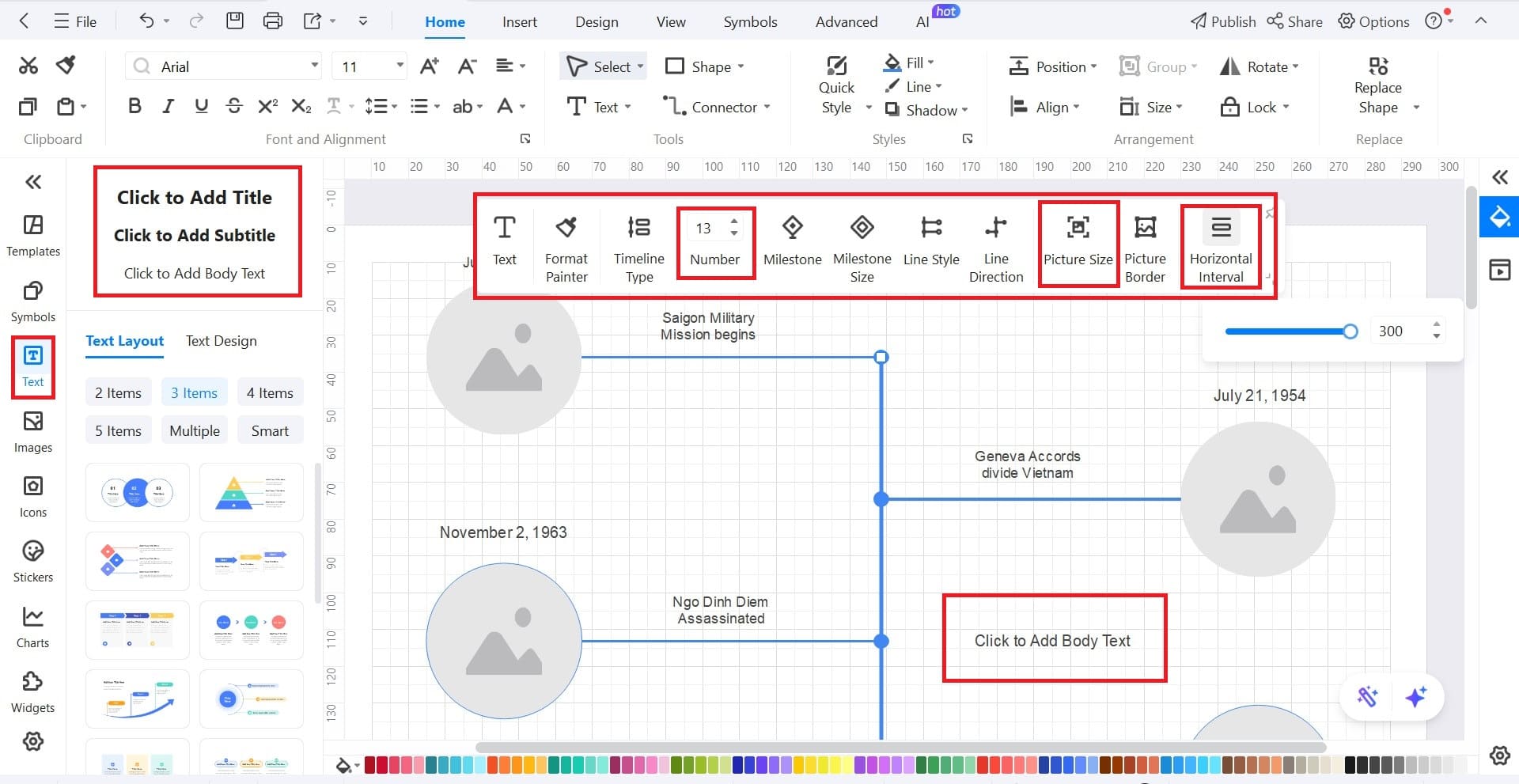
Step5Personalize the Design
- Select your timeline and change colors with the quick color bar below.
- To insert images: Insert > Picture > Local Pictures.
- Want a background? Go to Design > Background Picture or upload your own.
- Once added, right-click and select Send to Back to place it behind the timeline.
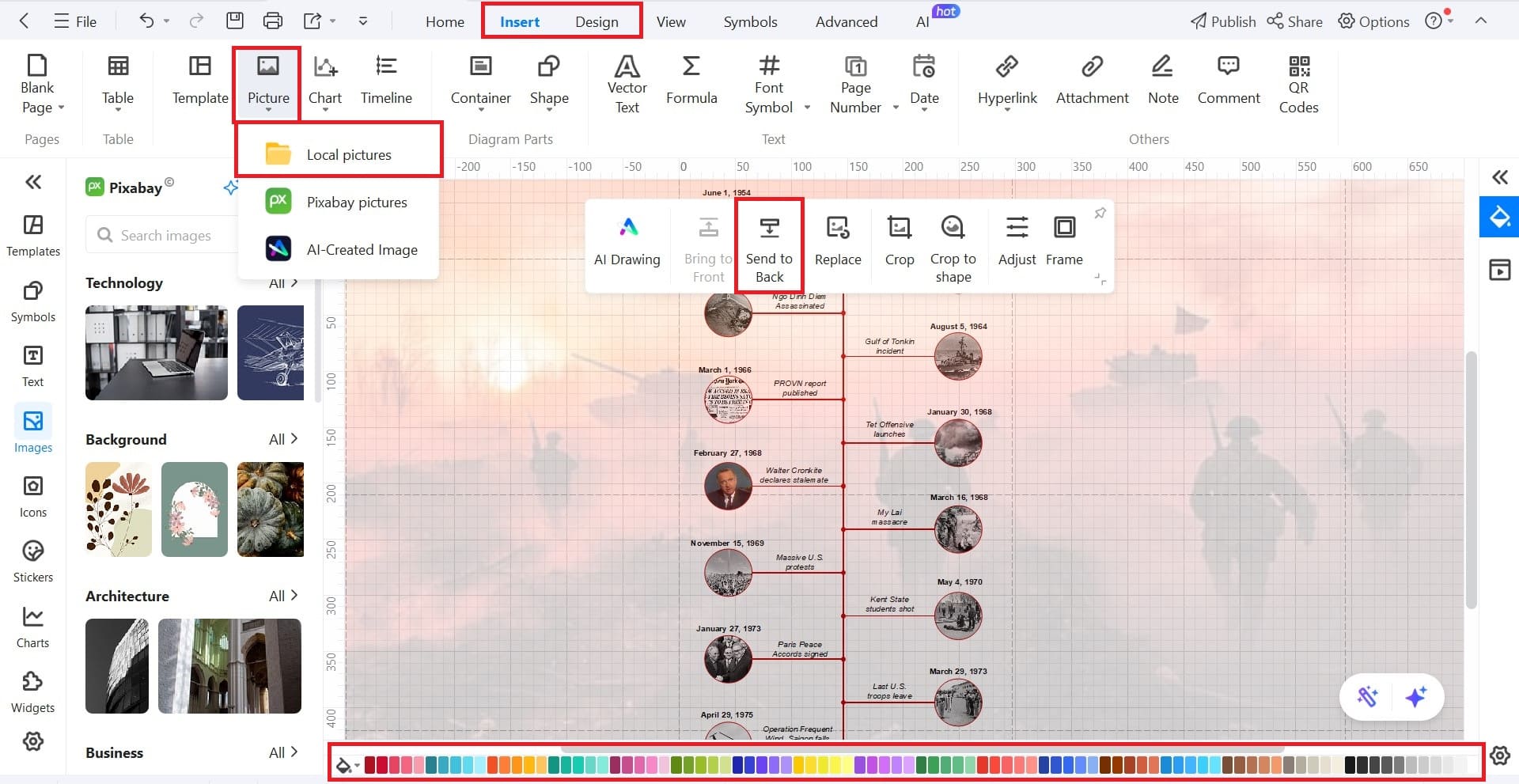
Step6Save and Export
- When everything looks good, click the Export icon on the quick toolbar.
- Choose the format you need and hit Export.
- That’s it – your timeline is ready to share!
- To share, head to the Share icon on the quick-access toolbar.
- From there, you can generate a link with your preferred visibility.
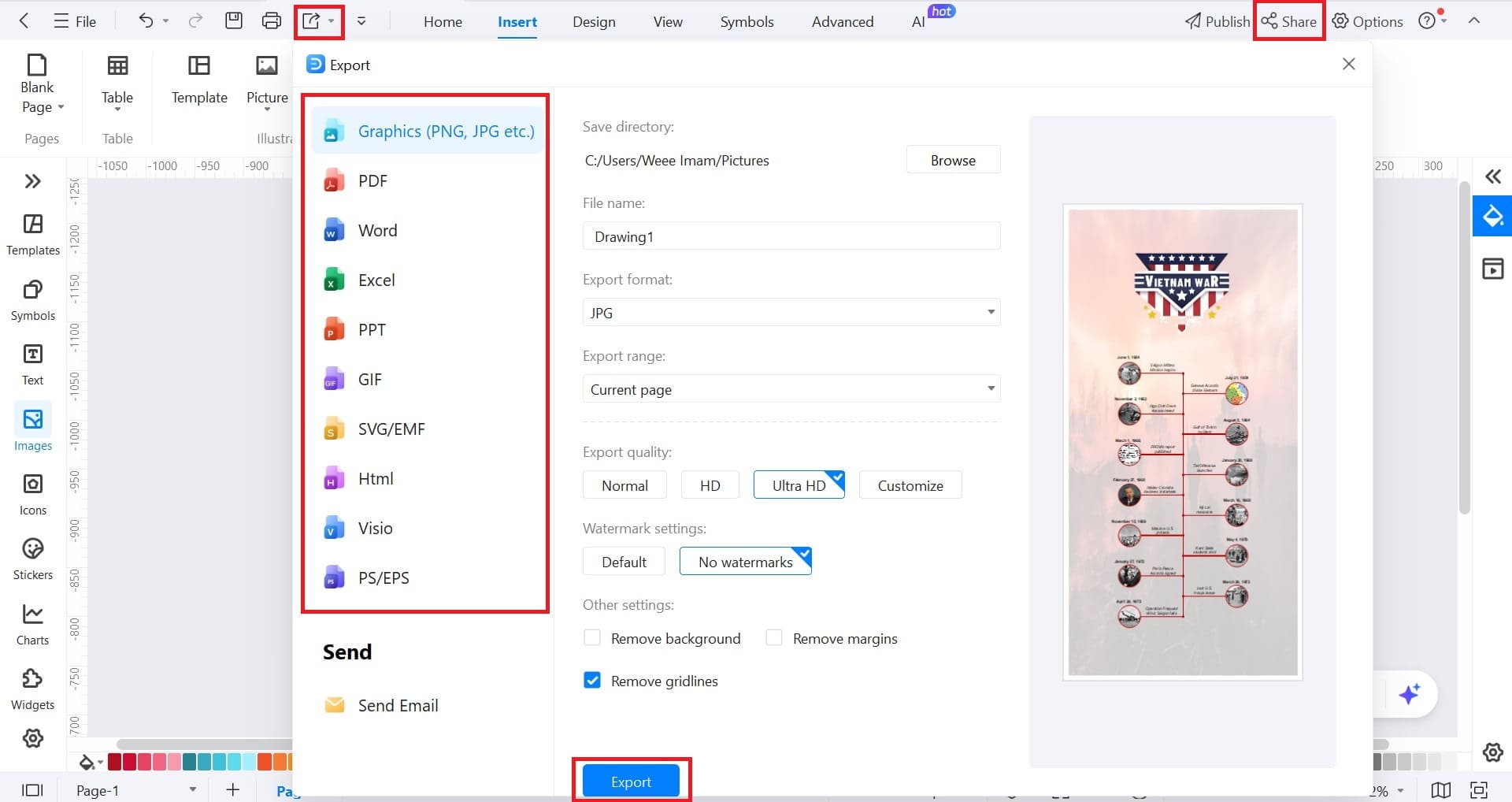
Final Remarks
The Vietnam War is a brutal chapter of history. Not just for Vietnam itself but also for the US. It is a reminder of the huge costs of conflicts. And how easily those costs are ignored as collateral damage. In many ways, the Vietnam War forced the world to question what victory really means. Looking back, it reminds us how power struggles ripple into everyday lives.
And if you’d like to preserve complex histories like this in a simple, lasting way. EdrawMax has your back. Whether you’re using it for your history lessons or presentations, it’s the go-to tool for timelining.




